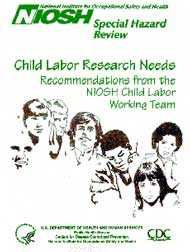Child Labor Research Needs
DHHS (NIOSH) Publication Number 97-143

Recommendations for Coordination, Collaboration, and Partnerships
Protecting young workers in the Nations labor force requires the efficient efforts of multiple stakeholders. Several Federal agencies have active programs, and the need exists for routine communication, collaboration, and coordination of these programs. A number of State programs exist to protect young workers, and Federal agencies may cooperate in these efforts. Finally, the public sector should be an active partner in protecting working children and adolescents and preparing them for the world of work.
Interagency Coordination and Collaboration
The DOL has a number of agencies active in areas that affect young workers. The Wage and Hour Division of the Employment Standards Administration establishes Federal child labor standards, including standards for employing workers and standards listing certain types of work as too dangerous for children. NIOSH and the Wage and Hour Division have worked closely on several of these issues. NIOSH should continue to provide technical expertise to the Wage and Hour Division and to encourage the DOL to review and update child labor standards routinely as new data accumulate.
OSHA has jurisdiction over safety and health in the workplace, including certain workplaces employing a high percentage of young workers. Some of these workplaces (such as eating and drinking establishments) have high rates of injury. NIOSH needs to coordinate efforts with OSHA in studying injuries and illnesses among young workers in these industrial sectors. NIOSH should encourage OSHA to consider youths when setting standards and targeting interventions. OSHA should also be encouraged to continue the cross training of OSHA inspectors on child labor issues.
NIOSH should encourage BLS to conduct surveys and report data in a form that provides information about young workers. Surveys should include information about workers under age 15, and data should be published in age groupings that facilitate interpretations of child labor issues. BLS should be encouraged to address survey design issues such as the use of proxies, which may contribute to inaccurate estimates of youth employment. Finally, BLS should be encouraged to conduct periodic supplements to the CPS to generate stable, State-specific estimates of youth employment.
NIOSH should also work with the School-to-Work Office (which is jointly administered by the Departments of Labor and Education) and the Office of Vocational and Adult Education within the Department of Education to ensure that youths in these programs work in safe and healthful work environments and receive knowledge and skills in occupational safety and health. NIOSH should also encourage these agencies to institutionalize the reporting of injuries and illnesses associated with school-based or -facilitated work experience programs (as British Columbia does [Province of British Columbia Ministry of Education 1995]). NIOSH should work with the Division of Adolescent and School Health of the National Center for Chronic Disease Prevention and Health Promotion (CDC, DHHS) to include basic occupational safety and health in school health efforts.
NIOSH should encourage other agencies that conduct surveys of youths or families to incorporate questions that fill data gaps about outcomes of youth employment. Examples of such surveys are the Health Interview Survey conducted by the National Center for Health Statistics (CDC, DHHS), the Survey of Income and Program Participation conducted by the Bureau of the Census, and the Youth Risk Behavioral Surveillance System conducted by the Division of Adolescent and School Health of the National Center for Chronic Disease Prevention and Health Promotion (CDC, DHHS).
NIOSH should communicate regularly with the National Center for Injury Prevention and Control (CDC, DHHS) about issues surrounding youths. Such communication would identify potential collaborations and foster the exchange of information about risk factors for adolescent injury. The Office of Rural Health Policy of the Health Resources and Services Administration (DHHS) has programs directed at young workers on farms, as does the U.S. Department of Agriculture. The Child Labor Working Team has representatives from both groups.
NIOSH and other Federal agencies should coordinate research and intervention efforts when young workers are exposed to toxic substances with chronic effects -- especially carcinogens and neurotoxics. The U.S. Environmental Protection Agency (EPA) has made children's health a priority and is developing risk assessment models for children and infants [APHA 1996]. The Agency for Toxic Substances and Disease Registry has a new childrens' health initiative that emphasizes child health in all of the Agency's programs and activities.
NIOSH should communicate with the Maternal and Child Health Bureau of the Health Resources and Services Administration (DHHS) to determine its possible role in their program entitled Preparing for Adolescent Transitions: Healthy and Ready for Work.
State Partnerships
States often serve as the jurisdictional unit for intervention and data collection efforts. NIOSH should recognize State roles in research and prevention and use the expertise they can provide. NIOSH should also promote its ability to provide technical expertise to States.
Private Organization Partnerships
NIOSH should continue to encourage relationships with labor and trade organizations, child health advocates, and research and public health groups to promote safe and healthy workplaces for youths. NIOSH needs to be responsive to the information needs of these groups and to use them to disseminate critical information about occupational safety and health for youths.
- Page last reviewed: June 6, 2014
- Page last updated: June 6, 2014
- Content source:
- National Institute for Occupational Safety and Health Education and Information Division


 ShareCompartir
ShareCompartir